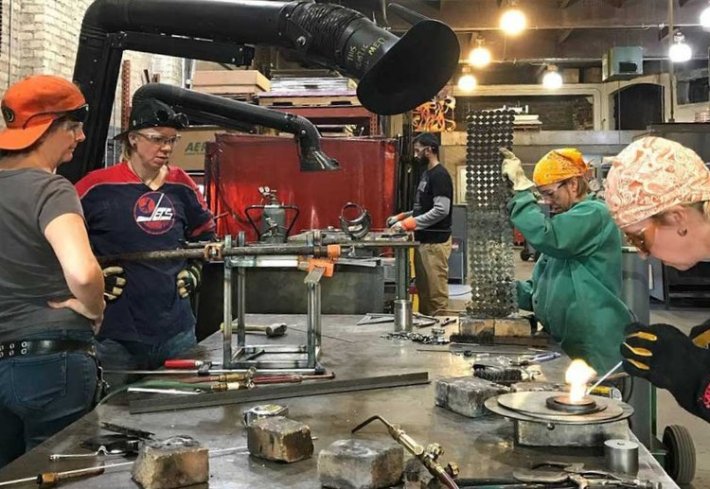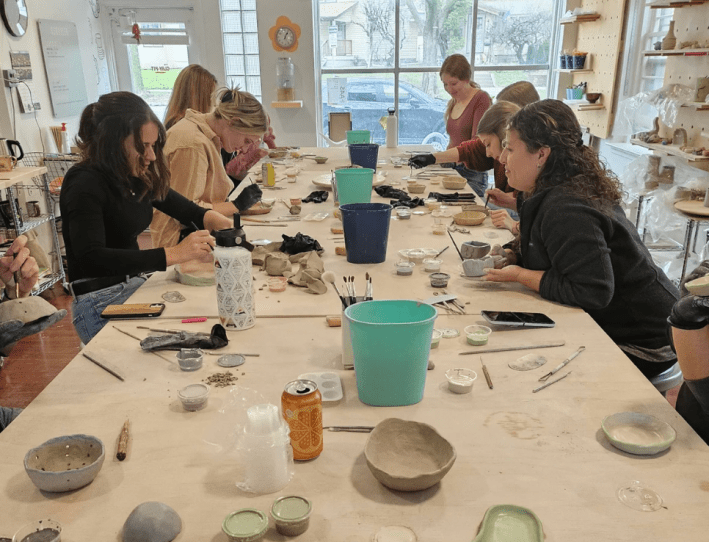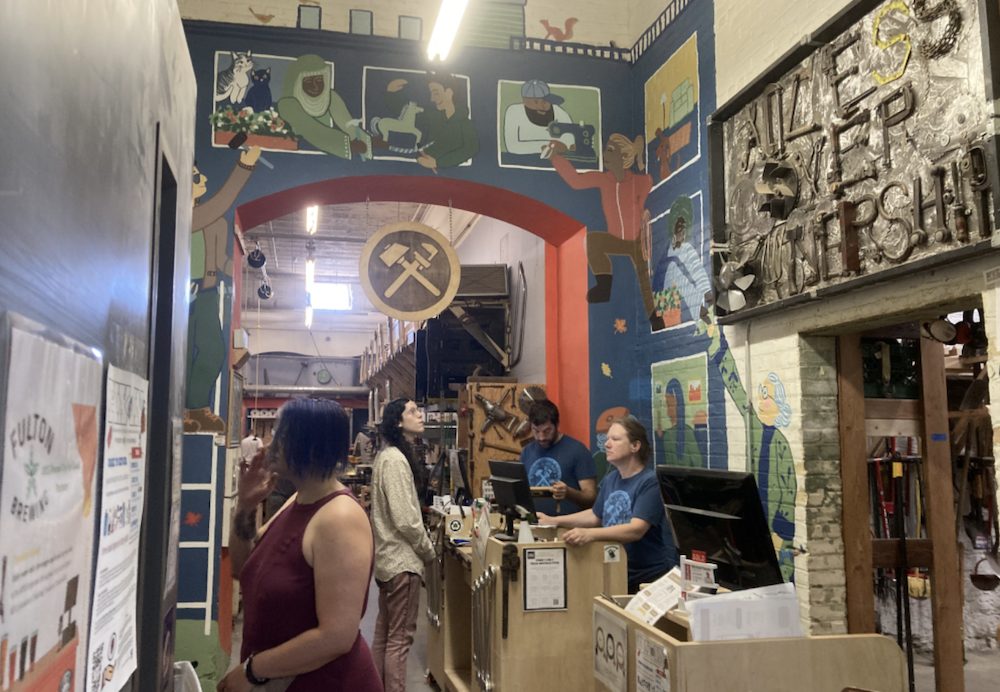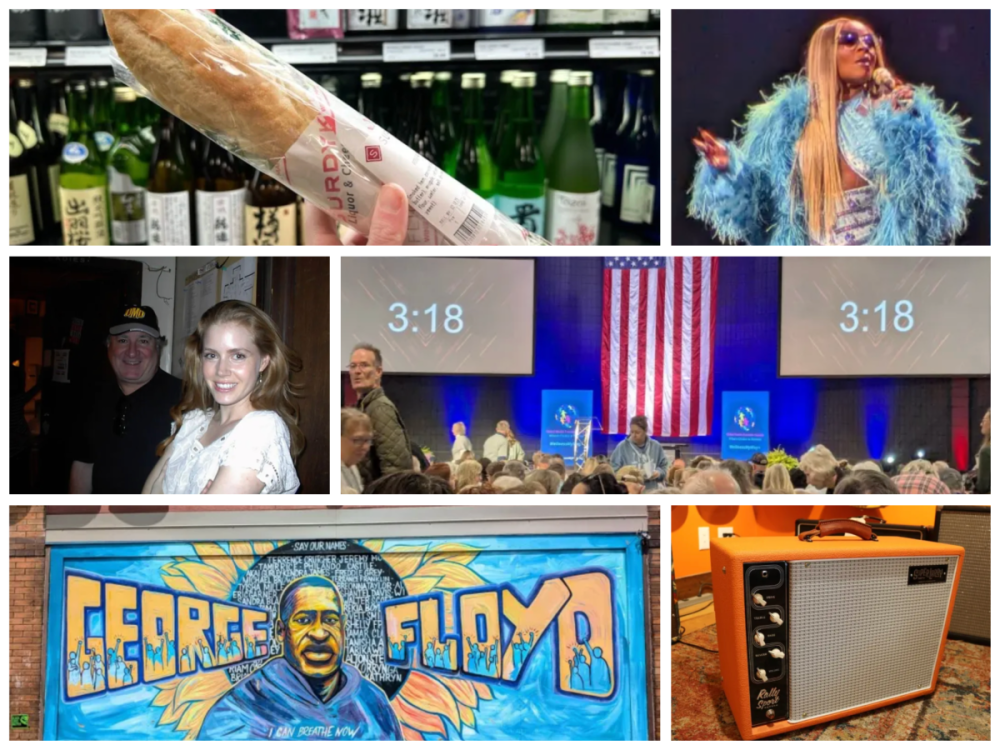Many people have written about the death of the third space, a place that isn’t home or work where people hang out and build community. Malls are struggling to reinvent themselves; Starbucks isn’t as cozy as an independent coffee shop; and even when people do want to hang, corporations call it loitering and discourage them with hostile architecture.
But those types of third spaces always relied on extracting maximum profit by leveraging the latest consumer trends. They never existed to build community—they were built to advertise and get at your wallet. As third spaces go, these were always the shittiest.
The real third spaces have been with us all along. They’re the skateparks where folks of all ages flock to. The local bar that hosts a regular book club. The dog-friendly area by the lake. The volunteer-run businesses.
Community-focused maker studios are another type of third space, one where people skill share, troubleshoot DIY projects, and, sometimes, play with things like lasers cutters, power washers, and mitre saws. At least three major maker places are celebrating milestone anniversaries this year, and new ones are popping up every year.

“Access Over Ownership” at the Minnesota Tool Library
It’s hotter than the sun on the day I venture into the Minnesota Tool Library on Central Avenue in northeast Minneapolis’s Thorpe Building. Though it’s a Tuesday afternoon, the small but very mighty shop is hoppin’. People chat at the checkout desk, folks power-saw wood planks in the open studio area, a couple holds hands and inspects the tool donation bins at the front, all while a steady stream of people come and go, pulling wagons that haul power washers and leaf blowers to and from the parking lot. Like worker bees, members are just buzzing around, doing their own thing.
“As a non-traditional worker like myself—where you're not in the trades all the time—more traditional maker spaces can still feel very claustrophobic,” says Executive Director Kate Hersey. “The library provides the support and there are people here that can help you, but if you don't want it you can just come in and do your own thing. You're not hovered over.”
That community “do as you want” vibe seems to be working. The Minnesota Tool Library began in 2015 as an idea between cofounders Thomas Ebert and Zach Wefel, who met at a Windom Park neighborhood meeting. The two bonded over being new owners of 100-plus-year-old homes, and when Ebert mentioned Station North, a nonprofit tool library in Portland, Oregon, they decided to do something similar in Minneapolis.
The Minnesota Tool Library was so popular that, two years later, a second location was established in St. Paul. And, barring a few funky pandemic years, its membership has steadily grown. Today there are over 1,900 members, and Hersey estimates about half are women. An annual household membership costs $120 (there are also need-based scholarship opportunities).
That membership scores users access to all kinds of tools, from the major (air compressors, circular saws, sewing machines) to the minor (jumper cables, rakes, brooms, wrenches)—things you might need to get the job done. More intense items (3D printers, scroll saws, lathes) can be reserved for use at the facility. An online database allows users to see tool availability, reserve items (or extend a loan), purchase any one-time use parts (think sand paper or one-project filters), and get instructions on how to use items. In total, there’s over 8,000 tools in the library. High-demand items this season include lawn mowers and cement mixers.

This is a nonprofit, volunteer-run outfit. There are nine part-time employees and Hersey estimates around 30 to 50 regular volunteers at any given moment who help clean, host classes and workshops that anyone can sign up for, or simply share knowledge with other members while hanging out in the shop. Those core volunteers have a big impact on what the space can do.
For instance: “When we've got really active social media, it's because we have a volunteer who's really passionate and wants to do our social media,” Hersey says. “Our programming is very much reliant on the capacity of our volunteers.”
Perhaps most importantly, Minnesota Tool Library aims to be equitable, accessible, and approachable—which is not always the case in a traditionally male-dominated craft.
“One of my favorite stories is we had this lovely woman come to one of our classes,” Hersey says. “She had just moved into a retirement complex that happened to have a wood shop. She was really excited, because she had always wanted to do carpentry, and never had that opportunity.”
In high school, that woman had been pushed into home-ec classes, and her husband had done all the handiwork. When she went down to the retirement home’s shop, a number of gentlemen did not want her there.
“They were like, ‘We're not gonna teach you how to do anything,’” Hersey recalls. “If a grandson had walked in that, everybody would have been on them like, ‘Let me show you how to do this.’ She was just gutted.”
Not wanting to be a burden to the grumpy old men, the lady gathered her bridge club and signed up for a shop class at the Tool Library.
“They were all a-twitter and super excited,” Hersey says. “It was the sweetest thing in the world, right? So they're now all empowered and they go back and just flabbergast these gentlemen and take over the wood shop.”
The bridge club now meets monthly at the complex’s wood shop to make things like toys for their grandkids and useful home items.
With MTL membership growing, square footage has become a precious commodity. The library may expand to Duluth and Greater Minnesota, and they’re also looking to add tool lockers with a self-checkout kiosk.
“So, like, Amazon-style lockers,” Hersey explains. “We'd be able to have a locker system where our members could pick up and drop off a few things that they need.”

Twin Cities Maker: When 14 Shops Isn’t Enough
Like the Minnesota Tool Library, Twin Cities Maker celebrates an anniversary this year—its 15th. But what would become a full-blown community space with thousands of dollars in heavy-duty equipment and supplies actually started out as a website forum.
After receiving a profile on the tech website CNET, Twin Cities Maker’s website traffic exploded. That led to plans for an in-person meetup at (now closed) Anodyne Coffee. Sadly, only three people showed up. So the trio of posters decided to drum up interest using an old Minnesota mind trick.
“They decided to lie,” says Sage Kaplan-Goland, TCM’s president. “They went on [the forum] the next day, and were like, ‘Oh, we had such a blast! It was packed! Everybody should come out next week.’”
At the next get-together, 30 people showed up. The club eventually became a regular event at the (also gone) Common Roots Cafe, collecting dues in the hopes of eventually finding a location where they could work and store their tools. That year they would merge with another maker group, the Hack Factory, and sign a lease on their first humble space in Minneapolis’s Longfellow neighborhood.
In 2025, Twin Cities Makers may still be humble in attitude, but not in offerings. Located at 3119 E. 26th St., their building is 13,000 square feet—literally 10 times what they were working with when they first opened. There are currently 11 shops, including a fiber arts area, 3D printing facilities, a welding area, woodworking stations, a laser room, and a computer room. A living room area, complete with a pea-green midcentury couch and other seating in the lobby, is a popular spot for impromptu naps as well as “Fiber Night,” a meetup of crochet and knitters.
“And we're adding three more [shops] this summer in a building we're already kind of crammed into,” says Kaplan-Goland, referencing plans for areas dedicated to wool work, ceramics, and lapidary (gemstone) arts.

Simply put, the facility is epic, and every nook and cranny has been put to use, including the ceiling, where an in-progress dining room table and kayak are stored. Workshops are busy, but not cramped, with a handful of people waving “hi” as we explore several rooms. Kaplan-Goland notes that our tour comes in at about an hour; more intensive tours of the facility can take as much as five while he says his personal record for succinctness is 40 minutes.
When Twin Cities Maker first opened its physical space, they were a nonprofit with 24 members. That number is much bigger these days. “In the past five years, we've gone from 130, 140 members to… I think we'll be at 560 next week,” Kaplan-Goland notes.
Memberships cost $85 a month or $460 for six months, with need-based help available to those who apply. That also includes your own storage area, a precious amenity that is rarely free in these kinds of setups.
That membership, as well as about 50 core volunteers, have helped make the TCM what it is today, quite literally. In recent years they’ve helped design an extensive security camera set up, an electronic fob system that unlocks machinery based on member training, and a ceiling tiling system that runs water from the leaky roof into a designated bucket. When the workshop hosts its quarterly cleanup, often over 100 people show up and get the job done before noon.
Volunteers can also help talk you down when a project isn’t going as planned.
“Last summer, I built a dining table from scrap. It was huge, 10-feet long—the biggest project I've ever done and heaviest,” Kaplan-Goland says. “I had told all my friends I was going to serve them a meal on Friday evening at 7 p.m.”
But by 1 p.m. that day, those plans seemed overambitious. As they were trying to assemble the hinges, the soft brass screws were snapping. Things appeared dire. Tears were about to be shed. Then Drew, the wood shop manager, appeared.
“He came over and was like, ‘Are you OK? Do you want some help?’ I was like, ‘I have to serve a meal on this table in six hours. I haven't started cooking,’” says Kaplan-Goland. “He pulled out a tube of paste wax, and was like, ‘What you're gonna want to do is dip each screw in the paste lab and then screw it in.’ I was pretty skeptical, but every single screw from that point on went in like butter. Totally perfect.”
With Twin Cities Maker’s growth also comes growing pains and changes. As president, Kaplan-Goland is basically working a second (unpaid) job; he estimates that he dedicates about 40 hours a week. Around 50 core volunteers work to set up programs, classes, and skillshare opportunities, but burnout or life changes are common. The organization recently hired its first staff member and plans to add a second soon.
“Our growth has really been super exciting, and it's letting us do more cool things, but also this used to be more of a club that had nonprofit status, and, you know, things were broken all the time—and that was fine,” says Kaplan-Goland. “So we're trying to live up to being a little more. Not too professional but more reliable, more equitable and justice focused. We’re really thinking about how we can be the best resource for the community.”
Sometimes that comes down to making more room for more people. This summer, the nonprofit signed a purchase agreement for the 43,000-square-foot, 117-years-old grain mill at 3400 Cheatham Avenue in Longfellow, which they hope to use for expansion while also bringing in other community groups by offering low-cost leases.
For now that comes down to unlocking city funds and fundraising for the down payment.
“Really the goal is to make it sustainable and affordable for everyone,” he says. “My dream is to get a dozen other nonprofits who each need 1,000 square feet or something to keep doing the things they want to do, and to take away that worry about ‘Will we have a space to be next month?’ because everybody I talk to is on a month-to-month lease.”

Clay and Fire, Sometimes All at Once
Places like TC Maker that offer a little bit of everything, are rare—and aren’t necessarily what every creative person is looking for. Some just want to work on one type of art, and that’s where more niche studios come into play. If you’re into glass arts, there’s Foci Arts Center. Print artists looking for access to presses can join the co-op at Highpoint Center for Printmaking. And some people like to play with fire in the safety of a workshop. That’s where Chicago Avenue Fire Arts Center (CAFAC) comes in.
“These are tools that often are very cumbersome and expensive and some of them are not safe to use by yourself, you know?” says Gallery Coordinator Jhyle Rinker. “So that's one of the reasons why we began; we saw a hole in our little artist ecology that needed filling.”
Like many other maker orgs, CAFAC started when a group of six neighbors met at a community meeting. They started riffing on the idea of building something dedicated to fine fire arts: welding, neon bending, jewelry making, metal pouring, blacksmithing. Fifteen years later, CAFAC continues to grow. In 2024, it managed 1,168 enrollments in 199 classes.
In addition to workshops, CAFAC also hosts gallery shows, an artist residency, open house/iron pour events, and a gift shop where you can purchase jewelry from its makers (a portion of those proceeds benefit its scholarship program, which anyone interested in classes can apply for). Workshops range from $40 to a couple hundred dollars.
That’s a lot of stuff for a staff of six (soon to be five) part-time employees to manage. Which is why it comes down to volunteers who host classes, do skill shares, and help keep the place up and running.
“We really do rely on volunteers for basic maintenance stuff and cleaning up and things that we just need support on,” Rinker says. “I mean, I started as a volunteer here.” (The next volunteer cleanup/potluck is actually this Saturday, July 12.)
Located at 3749 Chicago Ave., CAFAC’s community-driven mission has only deepened over the past few years.
“We are a community arts organization that is in George Floyd Square and, of course, that hasn't been without its struggles,” Rinker says. “But it also has been something that has allowed us to deepen some of that community building in ways that most places aren't able to.”

One new spot in town is the Clay Pit, which opened in April of 2024 inside the former Cry Baby Clay address at 4052 Chicago Ave. in south Minneapolis.
“As a broke 20-something, working at a studio was the only way to afford studio time and resources,” says shop founder Soren Aster. “As I worked, I met a lot of folks like me, broke and wanting a hobby and community, who were unable to regularly come in to create work, mostly because of the financial aspect of things but also because most of the people in those spaces were older ladies from the suburbs. It made me upset to know that folks were being left out or unable to create with clay.”
The Clay Pit uses an interesting business model. You pay to reserve a time or sign up for a studio session and that scores you a free bag of clay and firing. Generally an hour costs between $15 to $30, though sliding scale (and even free) options are also available. Those sessions are usually covered by donations to the community fund or by Aster themself.
“Even when the community fund is empty, I still offer a sliding scale,” Aster says. “I would rather have 10 people come in for $1 than one person come in for $10.”
Another way to score free time in the studio is to volunteer. The Clay Pit is a one-person outfit, and Aster says they rely on volunteers to help them make time to get admin-type work done. And that’s one way to build community.
So far the Clay Pit has been a hit, with 15 to 30 folks regularly stopping by weekly for open studio hours and workshops ranging from “six to 60” people signing up. Queer Night, hosted the last Wednesday of every month, is especially popular.
“I feel the studio has become more of a third space for folks to hang out and get together, and I really want to embrace that with everything else going on in the world,” Aster says. “Community is definitely my number one drive.”







